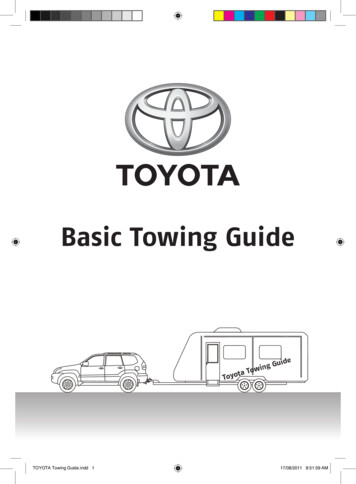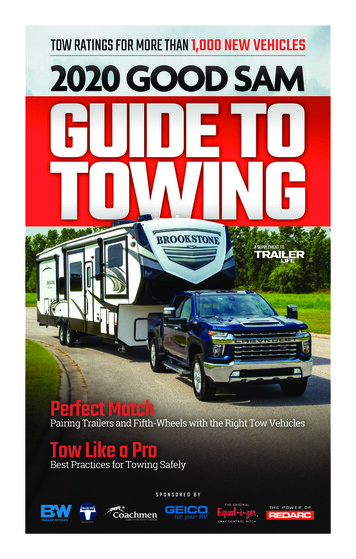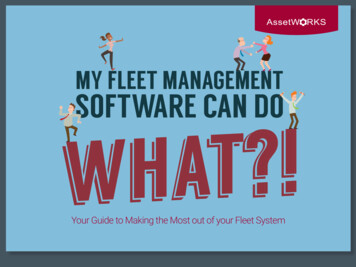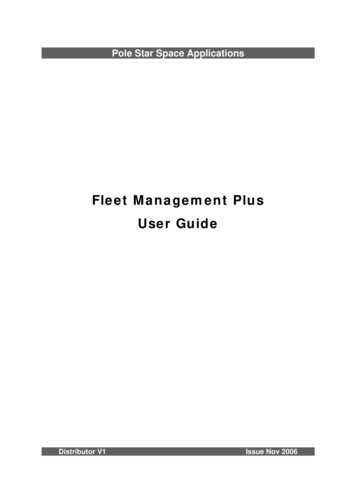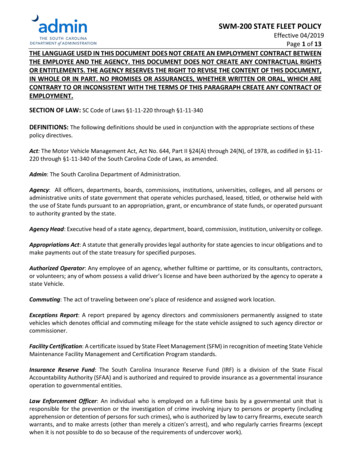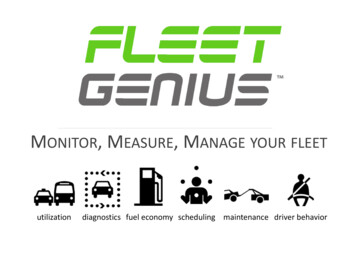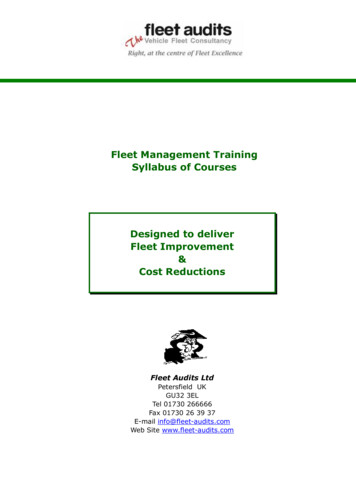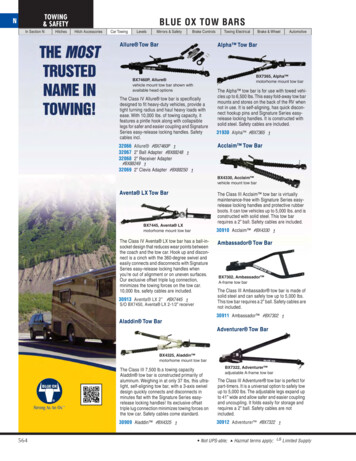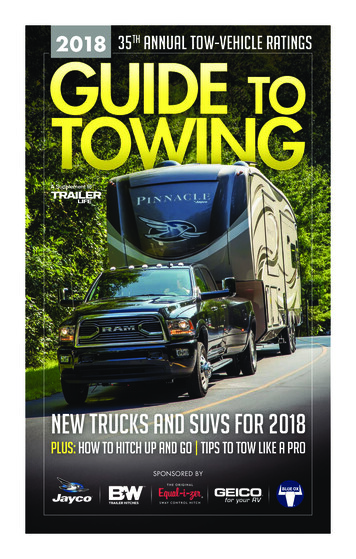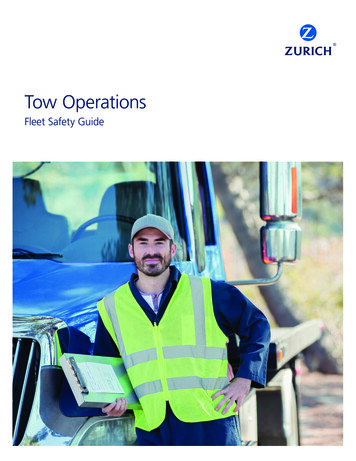
Transcription
Tow OperationsFleet Safety Guide
PurposeFleet safety and compliance is a critical element of a successful safety program. Companies that utilize auniform process to screen, train and monitor drivers have a greater potential to reduce risk and hazardousexposures. This reduction will help mitigate losses in regards to driver injuries from auto collisions, liabilitylosses due to damage and injuries inflicted on third parties, and physical damages caused to companyowned equipment. In addition, fleet safety programs should also address regulatory requirements andguidelines to help ensure that the company is operating within the guidelines of applicable state and federalregulations such as the DOT.Tow truck operations are no exception and at times introduce unique elements into the traditional drivingaspects of an operation. Drivers must have a current commercial license, a clean driving record andknowledge of vehicle maintenance and repair. Some employers also require certification from a reputableorganization, such as a college, technical school or the Towing and Recovery Association of America.Organizations have the ultimate responsibility to ensure that they and their drivers are operating safelyand compliantly. It is imperative that organizations take a proactive approach to help accomplish this task.Losses from being involved in a vehicle crash have the potential to be financially and emotionally devastatingto both the employer and the employee. Whenever an individual has a role in your organization that willrequire them to drive a vehicle, you should consider providing a formalized orientation session that providesboth training and guidelines for anyone operating a vehicle in your company.TopicsTow Operation Guide.3Regulatory Compliance.6Driver Selection & Screening.9General Liability Exposures.10Motor Vehicle Record (MVR) Guidelines.14Driver Training.17Vehicle Inspection.18Crash Reporting & Loss Investigation .192
Tow Operation GuideAn important aspect to remember is that tow truckoperators, at many times are part of the first responder teamat automobile accident scenes, joining police officers andambulance crews. As a result, it is vitally important that theyare properly trained and equipped with the necessary toolsto perform their duties. Any time a driver responds to anaccident scene or to remove a disabled vehicle, they must usethe proper tow vehicle, tow equipment (straps, chains), towprocedures and proper personal protective equipment (PPE).Personal Protection EquipmentThe Federal Highway Administration requiresthat all roadway and emergency workerson or near a federal highway wear a green,orange or yellow fluorescent safety vest thatmeets American National Standards Institutestandards. Three classes of vests are available,with Class 3 offering the most visibility. Inaddition to vests, tow truck drivers should alsowear proper work boots, gloves and otherequipment that the operation sees fit.Safety on the SceneA driver should monitor any activity aroundtheir tow truck as he/she approaches adisabled vehicle. The driver should arrive withtheir emergency lights on, and before exitingthe truck, must check for oncoming trafficapproaching the accident or disabled vehicle.As the tow truck driver exits and enters thetruck, they should check that they place theirfeet on the running boards of the truck anduse its handrails to keep from falling. The sameis true as the driver climbs into the tow truck’sbed. Drivers should also be using three pointcontact when exiting and entering the vehicle.EquipmentKeep all tow trucks well maintained. Scheduleregular preventiative maintenance and repair orreplace parts when necessary.Ensure that drivers are familiar with all trucksthey operate along with their capacities.Drivers should conduct a proper pre/posttrip inspection of the vehicles they operate.3Drivers should make sure the truck is freeof broken bolts, cracked seams and stressfractures and check the chains to make surethey are free of cracks and rust. Each drivershlould also be aware of tow capacity andnever to exceed itA tow truck driver is licensed to haul acertain weight of cargo. The gross vehicleweight rating, or GVWR, for light-dutytrucks is 10,000 pounds or less. Mediumduty trucks can haul as much as 26,000pounds, and heavy-duty haulers can movevehicles with a GVWR in excess of 26,000pounds. The weight ratings also indicatethe types of winches and towing cablesthat can be used on a particular tow truck.The tow truck driver should inspect thecables and wenches regularly to ensurethat they are in good working order. It isalso important that the driver regularlyinspect all splices and connectors thatfasten the tow wire to the truck and to itshitching devices.Proper LoadingA tow truck driver must observe properprocedures as they load a disabled vehicleonto the tow truck. The driver should workwithin a designated safety zone to stay outof the way of traffic. The vehicle must becentered on the bed of the tow truck. Onceit is in place, the vehicle must be tied downand have its wheels chocked and blocked. Ifthe tow trucks are equipped with a remotecontrol for the lift, boom or winch, have your
drivers lock and secure it inside the truckuntil they are ready to use it isn’t accidentallyactivated. Once the vehicle is lifted, driversshould not be working underneath it.Keep a Safe DistanceRemember that your drivers are carryingextra weight when towing a vehicle, sodrivers should be driving defensively. Driversshould be obeying all speed limits andproper following distance. Distance betweenthe vehicle in front should be adjustedas needed especially in adverse weatherconditions. It is important for drivers to leavethemselves an out.Below are some additional basic stepsthat drivers should be taking. Get information about the vehicle yourtow truck driver will be servicing fromthe dispatcher via radio or phone. Thisinformation usually includes the vehiclemake and model, color, location, thereason for towing and the driver’s name.4 Speak with the customers to learn thedetails of the vehicle’s problem. Then, havethe tow truck driver explain the solution insimple language. The driver must be ableto remain helpful and polite when dealingwith customers who may be anxious, angryor otherwise upset. If permissible by both company policy andthe customer, the tow driver can makesimple repairs such as replacing flat tiresor spark plugs, jumping batteries andfixing disconnected or broken wires. If theproblem is an empty fuel tank, you maychoose to provide a few gallons to get thecustomer to a safe place. This may removethe need for the driver to actually towthe vehicle. Never exceed the gross vehicle weightrating or the safe towing capacity of thetow truck. Don’t expect your tow truckto tow loads equal to the tow rating.Tow ratings apply to loads imposedduring recovery with the tow truckproperly stabilized.
Never exceed the working load limits (WLL)of the tow truck or its accessories. Don’t use damaged cables on your towtruck. Become familiar with the varioustypes of cable damage. Carefully inspect allcables being used in a recovery operation fordamage before starting to pull. Be aware of and avoid electrical lines whenraising your boom. Don’t tow a vehicle on its front wheelsunless the steering wheel is secured withthe front wheels straight ahead. Alwayscheck manufacturer specifications beforetowing on drive wheels. After rigging cables, never begin pullingwithout rechecking connections. Makesure that all cables and snatch blocks aresecurely attached and cannot accidentallypull loose. Don’t permit bystanders in the area whileperforming recovery work. Don’t unlock outboard legs or rear jackextension legs unless the area under themis clear. Pay particular attention to keepingyour feet clear of this area. Don’t use a tow truck that has not beenproperly maintained. Be sure wreckermounting bolts are tight, cable is in goodcondition and all moving parts areproperly lubricated. After you have hooked-up a vehicle fortowing, don’t start the tow until you havedouble-checked the hook-up, installedsafety chains/straps (some product requirestraps and other product are designed tobe strapless - however all require safetychains), secured the steering wheel,released the parking brakes of the towedvehicle and installed tow lights. Don’t tow a vehicle at night without propertowing lights on the towed vehicle and thetow truck.5 Don’t substitute alloy chains for the originalfactory towing chains unless they areEXACTLY the same size as the originalchains. Even slightly smaller chains will NOTproperly fit the tow bar grab hooks. Grabhooks are made for a single chain size only. Don’t get under a raised vehicle or loadunless it has adequate safety blocksin place. Don’t continue to wind in winch cable afterthe hook is against the boom end. Don’t tow a vehicle on its drive wheelsunless steps have been taken to protectits transmission and differential. Followthe recommendations of the vehiclemanufacturer. As an alternative, use atowing dolly or car carrier. Don’t move your tow truck while eitheroutboard legs or rear jacks are extended. Don’t exceed ratings of booms, cables,snatch blocks or winches. Stay withinnameplate ratings. Note that boomratings decrease significantly as aboom is extended. When using a towing dolly, don’t exceedthe safe operating speed recommendedfor the dolly. Don’t use flashing lights except underconditions permitted by law. Don’t rely on anti-theft steering locks orsafety belts to secure the steering wheel.Use a special steering wheel clampingdevice. Rope is occasionally used to securesteering wheels, but rope is not as reliable asdevices designed for this purpose. Be sure that all pins or plungers on theL-arm receivers are engaged.Resources New York State Department ofMotor Vehicles, Supplement toDriver’s Manualfor Tow Truck Endorsement Tow Truck Driver Safety, DeniseBrown, Demand -14770.html–– International Safety EquipmentAssociation: American NationalStandard for High-Visibility SafetyApparel and Headwear–– State Compensation InsuranceFund: Tow Truck Operations–– Utah Division of AdministrativeRules: Utah Administrative Code–– Washington State Legislature:Minimum Tow Truck EquipmentStandards Responsibilities of a Tow TruckDriver, Lauren Treadwell, -tow-truckworker-15505.html–– Texas Department of Licensingand Regulation: Responsibilities ofTowing Operator–– Towing and Recovery Associationof America: National DriverCertification Program–– Contra Costa CountyDepartment of Conservation andDevelopment: Tow Operator JobDescription
Regulatory ComplianceThe Federal Motor Carrier Safety Regulations (FMCSR) canbe cumbersome and confusing, especially for operations thatare not entirely motor truck based. Typically, motor carriersthat haul freight, as their primary business, are well aware ofthe requirements needed to operate safely and compliantly.However, many companies operate vehicles as a secondaryaspect of their business and can overlook many of the FederalMotor Carrier Safety Administration’s (FMCSA’s) compliancerequirements. Some examples of these types of operationsare: tow truck operators, utility companies, constructioncompanies and companies that transport passengersWhen is Operating Authority required?AND is involved in interstate commerce:In order to operate commercial motorvehicles, organizations should confirmthat they have the appropriate operatingauthority and/or a USDOT number.Operating authority Motor Carrier (MC)numbers are required if a companytransports cargo for a customer orpassengers in interstate commerce forcompensation. Organizations that onlytransport their own cargo for themselves donot require an MC number. According to theFMCSA, organizations are required to obtaina USDOT number if they have a vehicle that3: Trade, traffic, or transportation in theUnited States Has a gross vehicle weight rating or grosscombination weight rating, or gross vehicleweight or gross combination weight,of 4,536 kg (10,001 pounds) or more,whichever is greater; or Is designed or used to transport morethan 8 passengers (including the driver) forcompensation; or Is designed or used to transport more than15 passengers, including the driver, andis not used to transport passengers forcompensation; or Is used in transporting material foundby the Secretary of Transportation to behazardous and transported in a quantityrequiring placarding.6 Between a place in a state and a placeoutside of such state (including a placeoutside of the United States); Between two places in a state throughanother state or a place outside of theUnited States; or Between two places in a state as part oftrade, traffic, or transportation originatingor terminating outside the state or theUnited States.However, please note that some statesrequire commercial motor vehicle registrantsto obtain a USDOT Number even if theyonly operate intrastate. A list of these statesis available from the FMCSA and can befound ed-usdot-number4When do drivers need a CDL?Gross Vehicle Weight Rating (GVWR) is akey item for an organization to review tohelp ensure that their drivers are qualifiedto operate equipment. GVWR can beconfusing and is one of the main causesof operating illegally. First, an organizationmust identify their vehicles’ GVWR todetermine if their drivers need a CDL. It
is important to note that the GVWR foreach vehicle is established by the truck andtrailer manufacturers, not by the companyutilizing it. For licensing purposes, acombined GVWR is determined by addingthe manufacturer’s GVWR Rating of thetruck plus the manufacturer’s GVWR of thetrailer. According to the FMCSA5: There arefour environmental conditions that causecold-related stress: Class A CDL is required when the GrossCombined Vehicle Weight Ratings(GCVWR) of the truck and trailer totals26,001 or more provided the GVWR ofthe vehicle(s) being towed is in excess of10,000 pounds. Class B CDL is required for any singlevehicle with a GVWR of 26,001 or morepounds, or any such vehicle towing avehicle not in excess of 10,000pounds GVWR. Class C CDL is required for any singlevehicle, or combination of vehicles, thatdoes not meet the definition of ClassA or Class B, but is either designed totransport 16 or more passengers,including the driver, or is placarded forhazardous materials. Please note thatbench seats cannot be removed to“lessen” the vehicles occupancy.A common misunderstanding of therequirements has to do with trailers with aGVWR in excess of 10,000 pounds when thecombined GVWR does not exceed 26,000pounds. Under these circumstances, a CDLis NOT required by FMCSA regulationsprovided that the vehicle is not placarded forhazardous materials.Please note that individual states mayimpose additional or varied requirement thatdrivers in their states must have a CDL orother special licensing in specific situations,so please check the requirements in eachstate where your organization operates. It isalso important to note that individual stateCDL licensing requirements CANNOT beapplied to drivers from other states.7Organizations that have drivers requiringa CDL and operate interstate must adhereto all federal regulations which include butare not limited to: maintaining a DriverQualification file, Medical Cards, annualmotor vehicle record (MVR) review andDrug & Alcohol Testing. Many states haveadopted the federal regulations and requirethat intrastate drivers operating equipmentover 26,001 are also required to adhere tothe same criteria5.Non-CDL Commercial MotorVehicle RequirementsCompanies that operate equipment ininterstate commerce with vehicle weightsbetween 10,001 and 26,001 and arenot hauling hazardous materials, may notneed their drivers to have CDL’s but may berequired to maintain a Driver Qualificationfile on each driver and each driver shouldhave a Medical Card.6 Additionally, suchcompanies become subject to many ofthe federal regulations including vehicleinspection and maintenance, hours ofservice and requirements for vehicle partsand accessories.Please note that organizations operatingin intrastate commerce will need to inquirewith each state specifically, as some statesdo not use the same 10,001 pound criterionfound in the FMCR’s.Implementing a DOT-regulated programThe FMCSA website offers a step-by-step listto help organizations properly register foroperating authority.7 Please see the belowlink to get ing-startedA next step is making a list of all of theemployees who may drive a commercialmotor vehicle for your company anddetermining what size and types of vehiclesthey may operate. This can help you toidentify whether special licensing may berequired or additional FMCSA regulationsmay apply.
Consequences for violatingthe regulationsMany companies, unknowingly, operatewithout proper authority and allow drivers tooperate regulated Commercial Motor Vehicles(CMVs) without the proper credentials.Often this practice goes unnoticed by theregulatory authorities. However, shouldyour organization be caught operatingwithout proper authority or allowing a driverto operate a regulated vehicle without aCommercial Driver’s License (CDL), the driverand/or vehicle may be put out of service.1 Ifyour vehicles and drivers are prohibited fromoperating on the road, your business may beessentially shut down and unable to satisfyyour customer’s needs.The FMCSA can also issue civil penalties tothe company for these violations. A fine fortransporting goods without proper OperatingAuthority is now a mandatory minimum fineof 10,000 for property carriers and 25,000for passenger carriers.The federal penalty to a driver who violatesthe CDL requirements is a civil penalty of upto 2,500 or, in aggravated cases, criminalpenalties of up to 5,000 in fines and/orup to 90 days in prison. An employer is alsosubject to a penalty of up to 10,000, if he orshe knowingly uses a driver to operate a CMVwithout a valid CDL.2In addition, an organization’s ComplianceSafety Accountability (CSA) system scorescan be adversely affected by driver andvehicle violations. For example, driversreceiving violations for not having a CDLwill automatically be entered into theCSA data base for a roadside inspectionviolation. The violation points mayincrease a motor carrier’s likelihoodof an intervention.It is vital that companies are able to identifywhich FMCSA requirements apply to theiroperations. Once identified, a comprehensiveprogram should be put into place to helpensure compliance.8References1. F ederal Motor Carrier Safety Administration. Federal Motor Carrier Safety Regulations(FMCSR) – Part 392.1(a). Web 3 November 2014. http://www.fmcsa.dot.gov/content/3929a .2. Maine Motor Truck Transport Association. Congress Raises Fines for Operation WithoutAuthority. Web 3 November 2014. s-fines-for-operating/5 .3. Federal Motor Carrier Safety Administration. What is Operating Authority (MCnumber) and who needs it?. Web 3 November 2014. ity-mc-number-and-whoneeds-it .4. Federal Motor Carrier Safety Administration. Do I Need a USDOT Number?. Web 3November 2014. dot-number .5. Federal Motor Carrier Safety Administration. Commercial Driver’s License Standards;Requirements and Penalties (Guidance). Web 3 November 2014. on/383.91?guidance .6. J J Keller. Driver Qualification FAQs (Provided by Fleetmentor). Web 3 November 2014.http://www.jjkeller.com/shop/content bi-driver-qualification-hiring-faq7. Federal Motor Carrier Safety Administration. Getting Started with Registration. Web 3November 2014. ted .8. N ational Safety Council. Motor Fleet Safety Manual (5th edition), Chapter 2,Elements of a Fleet Safety Program. Web 3 November 2014. http://www.nsc.org/safety work/resources/documents/motorfleet 5thed coverch2.pdf .
Driver SelectionWhen employees are hired, or contracted, whether drivingwill be their primary or secondary job responsibility, theyalready come with some degree of driving experience —good or bad. Driving is a personal experience influenced bya variety of factors.Only one person can be behind the wheelat any given time, and that individual musthave the skills and training to react properly inmany situations, such as: City, suburban, or rural driving Different vehicle types Heavy or light traffic patterns Interstate or highway driving Distractions, both inside and outsidethe vehicle Changing weather conditionsBecause people do have such different drivingbehaviors, habits, and abilities, employersare challenged with the very difficult andimportant task of selecting good drivers.Effective fleet management begins withgood drivers.The quality of job performance affects thesuccess of the entire fleet operation anddirectly influences fleet safety performance.Every effort must be made to select the mostqualified person for the job.Temporary, occasional and full-time driversshould be selected in the same mannerbecause they all represent the same type ofrisk by operating a motor vehicle on behalf ofyour organization.Establish Driver QualificationsManagement’s first step in selecting drivers isto establish a meaningful and realistic driverqualification program.Well defined job standards should be basedon objective criteria and reflect the necessaryprerequisites and skills for satisfactory jobperformance. Consideration must also begiven to the applicable parts and sections ofthe Federal Motor Carrier Safety Regulations(FMCSRs), if the job may include operation ofa commercial motor vehicle, as defined underthe regulations.9At minimum, the following shouldbe included:Job Description and DutiesFully describe the specific nature of theposition in order to recognize the bestapplicant. Determine exactly what theemployee must do, how it must beaccomplished, and include both drivingand non-driving aspects of the job. Writtenjob descriptions should be developed orreviewed at each location to determinewhich jobs require use of an owned or nonowned vehicles on company business.From this information, the essential jobfunctions of each position, as well as theexperience, skill level and other qualificationsneed to be summarized. Apply thesestandards equally for all job candidates toassure fair hiring practices.Physical QualificationsOnce the nature of the position is established,describe the minimum physical attributesrequired to perform the job, i.e., vision,hearing, health history, and substance abuse.When establishing these qualifications,determine if the driver is subject to theFMCSRs and/or State regulations, and applyany minimum qualifications where required.Background RequirementsDescribe the experience prerequisites theapplicant should possess for the job, such aslevel of education, amount of past training,previous driving experience, and degree ofdriving skill. If the job requires the driverto maintain a Commercial Driver’s License(CDL), additional training/experience may berequired under the FMCSRs, and should beaddressed in the experience requirements.Examples of such may include, but are notlimited to, entry level driver training, longercombination vehicle (LCV) driver training, etc.The candidate’s past driving record should alsobe included in these requirements.
General Liability ExposuresGeneral Abilities and AptitudesTo round out the driver qualifications, someless specific requirements might also beincluded. A “good driver profile” describedby the National Safety Council includes thedriver’s ability to: Avoid accidents Follow traffic regulations Care for the vehicle Meet schedules Get along with others Adapt to existing conditionsAlthough these may seem basic, they canbe an important factor in successfully hiringgood qualified drivers.Driver Selection ProceduresDrivers who meet well established criteriawill usually have the desired qualificationsnot only to perform their jobs but todo so safely. A variety of informationalresources and techniques is availableto assist management in the driverselection process, such as the ANSI Z15.12012 Safe Practices for Motor VehicleOperations, which is an industry bestpractices standard. Additional resourcesare also available from the FMCSA / DOT,10along with national and local truckingassociation affiliates.RecruitingAttracting well-qualified applicants isthe first step in the selection process.Advertisements should target qualifiedapplicants only. Minimum requirements forthe position should be highlighted in thead to help streamline the selection process.Applicants can be selected from a widevariety of sources, including promotingpresent associates, referrals from presentassociates, industry contacts, walk-ins, webbased and newspaper advertisements, tradeassociations, or driver training schools.Application FormThe employment application is the firstsource of information about prospectiveemployees. It is a valuable tool for narrowingdown the field of applicants to those bestqualified for the position. The form shouldcontain only questions pertaining to theapplicant’s ability to perform the job.Essential information should include personaldata, such as name, address, telephonenumber, previous employers, past positiondescriptions, period of employment, salary,and immediate supervisors. Examine theapplication prior to the interview and inquireabout any gaps in employment.
Application forms can be internal companyforms or can be obtained from regulatoryagencies such as the FMCSA, from generaloffice supply stores, or from industryvendors. Remember, the FMCSRs requirethat additional information be includedon applications for commercial drivers,so it is important to ensure the correctformat is utilized. Regardless of where theform is obtained, it is important that it beadministered according to fair hiringlaws and Equal Employment Opportunity(EEO) guidelines.InterviewingHold interviews in a relaxed atmosphere.Remember that the interview is a“conversation with a purpose” designed toobtain more information about the applicant.Verify or expand on information in theapplication form by encouraging applicantsto talk about past employment, training,and other qualifications. This process helpsthe interviewer form an opinion about theapplicant’s employment attitude, workethics, driving ability, and safety attitude. Inaddition, the applicant should gain a clearunderstanding of what the job involves andwhat the company can offer.Check the applicant’s driver’s license forexpiration date, identification number, andvehicle classification. The license should becurrent, valid, and of the correct type for theposition being filled. Consideration shouldalso be given as to the applicant’s accidentsand violations listed for the past three years,along with comparing such to the motorvehicle record (MVR). Any discrepanciesshould be explained by the candidate.Reference and Background ChecksCheck references to verify informationgiven on the application and duringthe interview. Research indicates thatpast performance may be an indicatorof future behavior, and it is one of thebetter resources available. One negativereference report should not be thesingle deciding factor in not hiring acandidate; however, if a trend emerges11that indicates questionable behavior,further investigation is warranted. Requestinformation pertinent to the applicant’spast employment to help determinesuitability for the job. For example,employment dates, type of work,equipment operated, accidents, and trafficviolations, along with any disciplinaryissues being verified as well.The two most practical ways to conductpast employment reference checks is inwriting or by telephone. Written referencechecks are valuable as a permanent recordand should be kept with the prospectiveassociate’s application and interviewnotes. Telephone reference checks arefaster and often produce more candidinformation. A checklist will help ensuregetting all the information needed andprovides a simple written record forthe files.The application form should request theapplicant’s signature to authorize thechecking of work references and MVR.Additional authorization forms may berequired, if not incorporated into theapplication, where operations may includeDOT regulated vehicles, and/or requiresthe driver to maintain a CDL. Due to thestrictness of today’s fair hiring laws, manypast employers are reluctant to divulgemore than past employment verificationinformation, i.e., dates of employmentand salary. However, the FMCSRs requireprospective employers to investigatespecific background information if theapplicant’s previous employment involvedthe operation of a commercial motor vehicle,and/or if the job position was designatedas a “safety sensitive” function in any DOTregulated mode,
tow truck driver will be servicing from the dispatcher via radio or phone. This information usually includes the vehicle make and model, color, location, the reason for towing and the driver's name. Speak with the customers to learn the details of the vehicle's problem. Then, have the tow truck driver explain the solution in simple .
